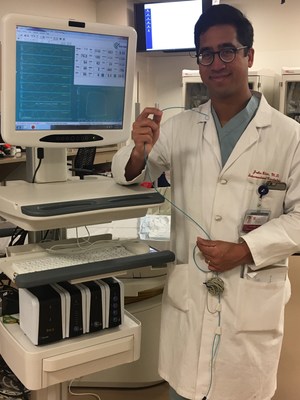Millar Grows Adoption Of Clinical Pressure-Volume (PV) Loops For Medical Research With Purchase Of Inca PV System By The University Of Chicago Medicine
HOUSTON, May 15, 2017 /PRNewswire/ -- Millar, Inc., is pleased to announce that the University of Chicago Medicine has purchased the CD Leycom® Inca® Pressure-Volume (PV) Loop System sold in North America exclusively by Millar, Inc. to improve understanding of the physiology of patients with heart failure with preserved ejection fraction (HFpEF), a condition affecting more than half of heart failure patients.

The Inca PV System is the world's only FDA-approved pressure-volume loop system for human use. It allows visualization of the complete cardiac cycle in real-time.
John Blair, MD, assistant professor of Medicine at the University of Chicago, has been awarded a Scientist Development Grant by the American Heart Association, enabling him to move forward with his research on microvascular dysfunction in heart failure with preserved ejection fraction. This multimodality research project was designed to evaluate the pathophysiology of HFpEF using information gained from coronary physiology studies, cardiac magnetic resonance imaging, echocardiography, and biomarker analysis. Enrollment started in 2014 and will continue until summer 2018. The goal is to enroll 100 patients, including 60 patients with HFpEF, and 40 patients without HFpEF.
Blair studies how different coronary blood flow patterns relate to left ventricular structure and function in HFpEF. With the addition of high-fidelity hemodynamics using the Inca PV Loop System, he can collect real-time data about the pressure-volume relationship, cardiac contractile state, and loss of intraventricular synchrony during cardiac catheterization procedures. This will help heart specialists understand abnormalities in left-ventricular performance, stiffness, shape, and volume in patients with HFpEF.
Blair hopes to prove there are underlying sub-types of the disease based on the coronary microcirculation. Identifying specific sub-types should lead to better therapies for these groups of patients. Based on research results, targeted drug therapies for each sub-type may help reduce the morbidity and mortality rates of HFpEF patients and improve their outcomes.
James Liao, MD, section chief of cardiology at UChicago Medicine, believes this technology will help doctors understand a wide array of cardiovascular diseases.
Blair, working with Nir Uriel, MD, director of UChicago Medicine's heart failure program, and colleagues Sandeep Nathan, MD, and Atman Shah, MD, co-directors of the cardiac catheterization laboratory, will enhance the reputation of the University of Chicago Medicine as a leading hemodynamics lab in heart failure. Adding the Inca PV System will facilitate studies in mechanical circulatory support, structural heart disease, coronary artery disease, and pulmonary hypertension.
About Millar, Inc.
Since 1969, Millar, Inc. has led the development of catheter-based, solid-state pressure sensors and is known worldwide as the leader in sensors that advance medical understanding. Today the company's clinical and life sciences products empower medical discovery and allow advanced cardiovascular diagnosis. Millar also delivers OEM solutions to the medical device and life sciences industries through our MEMS pressure sensors, ISO 13485 precision manufacturing and wireless power technology.

To view the original version on PR Newswire, visit:http://www.prnewswire.com/news-releases/millar-inc-grows-adoption-of-clinical-pressure-volume-pv-loops-for-medical-research-with-purchase-of-inca-pv-system-by-the-university-of-chicago-medicine-300456533.html
SOURCE Millar, Inc.

